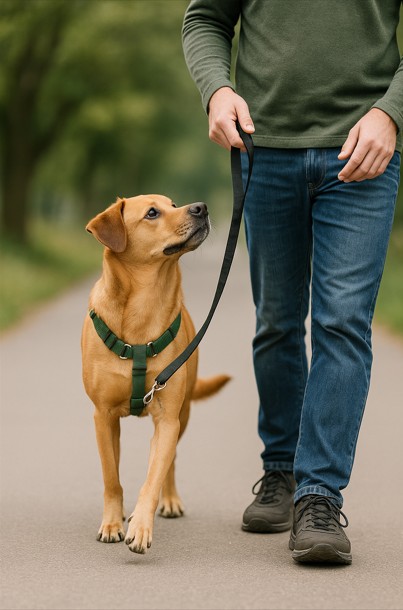A reactive dog isn’t a “bad” dog - they’re simply overreacting to a trigger that makes them feel uncomfortable or unsafe.
Common triggers include:
Reactivity often stems from fear, frustration, or lack of early socialization. The good news? With patience and consistent training, most dogs can learn to stay calm, even around their triggers.

Before addressing the behavior, learn to spot early warning signals. A reactive dog might:
Catching these signals early allows you to redirect your dog before a full reaction occurs.
Leash reactivity is especially common. When restrained, dogs can’t create space - their natural coping strategy. This loss of control builds frustration, leading to lunging or barking.
Dogs also sense tension in your leash grip or body language. The more you tighten up, the more they believe something is wrong.
That’s why reactivity training often starts with relaxation - for both of you.
Keep a simple journal for a week: note when your dog reacts, what the trigger was, and how close it was.
Patterns will emerge — maybe your dog reacts only to other dogs on narrow sidewalks, or men wearing hats.
Once you know the triggers, you can adjust distance or route to avoid overwhelming situations.
Your dog’s threshold is the point where they notice a trigger but can still focus on you.
Stay under that threshold and reward calm behavior with treats or praise.
Gradually reduce distance over multiple sessions as your dog gains confidence.
This method - called desensitization and counter-conditioning - replaces fear with positive associations.
When your dog looks at a trigger without reacting, calmly mark and reward:
“Good job!” → treat.
This teaches them that staying composed earns rewards, while lunging doesn’t.
Use high-value treats (like chicken or cheese) that your dog only gets during training walks.
If your dog begins to react, move away calmly. Avoid yanking the leash or shouting.
Walk in a gentle arc, keeping your tone upbeat — think “Let’s go this way!”
Distance reduces stress and resets focus faster than correction.
Teach your dog a reliable “look at me” or “leave it” cue at home first.
Then use it on walks to redirect attention from triggers.
Reward eye contact and relaxation. Over time, your dog learns to check in with you automatically when unsure.
Avoid retractable leashes or tight collars - they can increase tension.
Opt for:
In high-traffic areas, bring a lightweight barrier item (like your body or a car) to create quick visual space between your dog and triggers.
Progress with reactive dogs happens in small steps - not overnight.
Celebrate small victories, like calmly watching another dog across the street.
Avoid high-pressure situations until your dog has built reliable calm responses.
If your dog’s reactions are intense, unpredictable, or difficult to manage, work with a certified force-free trainer or behavior consultant.
Professionals can help you design a gradual desensitization plan that keeps your dog below threshold while rebuilding confidence.
Look for trainers certified through CCPDT or IAABC, and avoid those using punishment or aversive tools.
Cold weather can make walks more challenging for reactive dogs - limited daylight, bulky clothing, and icy footing add stress.
Try these adaptations:
Reactivity management is about building trust - not perfection.
Reactivity can feel discouraging, but it’s truly manageable with consistency, empathy, and time.
Your goal isn’t to eliminate reactions entirely - it’s to help your dog recover quickly and feel safe again.
Remember: calm behavior is learned through trust, not correction.
Each successful walk strengthens your dog’s confidence - and your bond.
Hit the trails with confidence! Our guide to the best dog leashes for hiking in Canada breaks down the top leash types - from hands-free to reflective - and shares expert tips for safe, comfortable adventures with your pup. Featuring trusted Canadian gear from Rocky Mountain Dog, this post helps you choose durable, trail-tested leashes built for every season and terrain.
Discover why Labradors thrive on fresh, whole-food meals tailored to their active lifestyle. This guide breaks down the best fresh dog food options for Labrador Retrievers in Canada, explains why balanced nutrition matters, and highlights top NutriCanine recipes made with human-grade ingredients. Learn how to transition your Lab safely to fresh food, manage their calories, and support long-term health - all while keeping mealtime easy and convenient with Canadian delivery from NutriCanine.
This article explores the best greeting exercises to stop dogs from jumping, barking, or biting when meeting people. It explains why dogs act out during greetings - often from excitement or overstimulation - and provides step-by-step training tips to promote calm behavior.
Discover practical and creative ways to keep your dog active indoors this winter. From games and training to DIY enrichment, keep your Canadian pup happy and healthy no matter how low the temperature drops.
When winter hits, knowing your dog’s limits is key. This vet-informed guide explains how cold is too cold for different breeds, the warning signs of overexposure, and simple tips to keep your pup warm and safe during chilly walks.